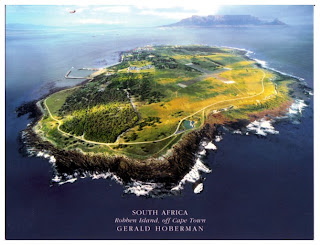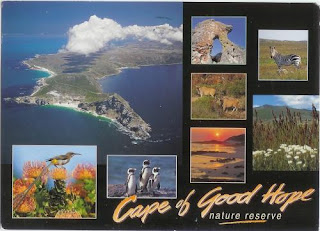Did you know that Robben Island and Table Mountain are the only World Heritage Sites visible from one another??

Proclaimed a UNESCO World Heritage Site in 1999, this bean-shaped island, the largest of South Africa, is situated in Table Bay with superb views of Cape Town 12 km away.

Used as a prison from the early days of the VOC right up until the first years of majority rule, Robben Island's most famous involuntary resident was Nelson Mandela. http://en.wikipedia.org/wiki/Nelson_Mandela
Our tour leader is a former inmate.......so let's go to South Africa's own 'Statue of Liberty'
As our boat approaches the island....our tour guide tells us that the former prison at Robben Island represents a critical chapter in the country's path towards democracy.
Robben Island has always been a site of heartbreak.
At times a leper colony, mental hospital and defence training base, this World Heritage Site is more famed as the prison to which anti-apartheid activists were banished.
A 'university of the struggle', its graduates went on to lead South Africa into democracy.
Here the leaders of the struggle against racial oppression, imprisoned for many long years, developed their concepts for a post-apartheid South Africa.
Isolated from family and friends, the Mandelas, Sisulus, Mbekis, Kathradas and Sobukwes of the time proved heroic men of steel, never wavering in their hope of a new day.
UNESCO's World Heritage Committee has chosen to mark this location for its "triumph of the human spirit'.

The sombre Robben Island prison buildings are now the home of the Robben Island museum.
As one of the world's great cultural world heritage destinations, Robben Island South Africa is memorable for both its tragedy and exultation, and its testimony to faith and spirit in the most humiliating of conditions.
The Robben Island Museum is centred round the notorious political prison where many of the leaders of the South African freedom struggle were imprisoned.
It is now a 'cultural and conservation showcase for the new South African democracy' - an international icon of the triumph of good over evil!!
At this museum on Robben Island, we learn that the first recorded landing on it was in 1498 when Vasco da Gama's support fleet took temporary refuge in its waters.
Its situation also made it ideal as a place of quarantine and during much of the later British occupation it was used as a leper colony.
But it is as a place of banishment and exile that it is notorious.
Miscreant sailors were offloaded here, as were Muslim activists fighting Dutch colonisation in the Far East.
The British, after taking permanent occupati on at the beginning of the 19th century, continued this tradition by banishing troublesome traditional leaders opposing settler incursion into the interior.
And in 1960 the apartheid government used the newly constructed maximum security section as a political prison, which is now the museum.

Prisoners were subject to hard labour and brutality, ....(oh look there is the limestone quarry that they worked in)....but few were broken and the tale of their experience is today symbolic of the triumph of ordinary people over an extraordinary crime against humanity.
Nothing has changed – physically.
Spiritually – voices once locked behind high walls speak their truth: 'we have overcome!'
Oh look Nopi, a lighthouse!
Jan van Riebeeck first set a navigation aid atop Fire Hill (now Minto Hill), the highest point on the island. 
Huge bonfires were lit at night to warn VOC ships of the rocks which surround the island.
The current Robben Island lighthouse, built on Minto Hill in 1864, is 18 metres (59 ft) high and was converted to electricity in 1938.
It is the only South African lighthouse to utilise a flashing light instead of a revolving light.
Its light is visible for 24 nautical miles and is the oldest lighthpuse in the southern hemisphere.
When the Dutch arrived in the area in 1652, the only large animals on the island were seal s and birds, principally penguins.
In 1654, the settlers released rabbits on the island in order to provide a ready source of meat for passing ships.
The original colony of African Penguins on the island was completely exterminated by 1800.
However the modern day island is once again an important breeding area for the species after a new colony established itself there in 1983.
The colony has grown to 13,000 and is now the third biggest for the species.
Our tour guide tells us a little about "Madiba"
Rolihlahla Mandela was born on 18 July 1918 at Mvezo in the Transkei, South Africa, to Nosekeni Fanny and Gadla Henry Mphakanyiswa (Chief Counsellor to the Chief of the Thembu clan).
(The name Rolihlahla means "troublemaker".)
He was given the name 'Nelson' by his first school teacher Miss Mdingane and the name 'Dalibhunga' after his traditional initiation in 1934.
He was later often addressed as 'Madiba' (the name of his clan) out of respect and affection.
A founder and leader of the ANC's armed wing, Umkhonto weSizwe (Spear of the Nation) which launched on 16 December 1961, Mandela was arrested on 5 August 1962.
He was charged for incitement and for leaving the country without a passport and sentenced to five years in jail.
He was sent to Robben Island but was taken to Pretoria to stand trial for sabotage in the Rivonia Trial.
On 11 June 1964 Mandela and seven of his comrades were convicted and the next day sentenced to life imprisonment.
Mandela was held on Robben Island for 18 years, at Pollsmoor Prison for six years and the final period of his imprisonment was at Victor Verster Prison in Paarl.
The highlight of our tour .....seeing "Prisoner 46664"'s prison cell.........as the tour guide unlocks the cell door....we get goose bumps.....
Nelson Mandela said "
I was assigned a cell at the head of the corridor.
It overlooked the courtyard and had a small eye-level window.
I could walk the length of my cell in three paces.
When I lay down, I could feel the wall with my feet and my head grazed the concrete at the other side.
The width was about six feet, and the walls were at least two feet thick. 
Each cell had a white card posted outside of it with our name and our prison service ]number. Mine read, "N Mandela 466/64," which meant I was the 466th prisoner admitted to the island in 1964.
I was forty-six years old, a political prisoner with a life sentence, and that small cramped space was to be my home for I knew not how long"
The number was imposed on him by the prison for over 25 years, until his release in 1990.
"Prisoner 46664" continues to be used, as a reverential title for him, and the Nelson Mandela Foundation uses 46664.com as its website address.
Shortly before Joe Strummer's death, he and U2's B
ono co-wrote the song "46664" for Mandela as part of the campaign against AIDS in Africa.
"Today when I look at Robben Island, I see it as a celebration of the struggle and a symbol of the finest qualities of the human spirit, rather than as a monument to the brutal tyranny and oppression of apartheid. It is true that Robben Island was once a place of darkness, but out of that darkness has come a wonderful brightness, a light so powerful that it could not be hidden behind prison walls… '
Nelson Mandela
This is an excursion that stirs the soul and inspires
Robben Island and its prison buildings symbolize the triumph of the human spirit, of freedom, and of democracy over oppression!!














































 Durban Time
Durban Time



3.Sao Paulo, Brazil